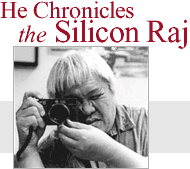The Rediff US Special/ Nirshan Perera


Who are the faces behind the high-tech boom? If you ask the average American, media images of Bill Gates, Steve Jobs, and Jeff Bezos immediately spring to mind.
People like Kanwal Rekhi, Sabeer Bhatia and K B Chandrasekhar may be dimly recognizable. But compared to the apple pie titans, they're bit players. Besides, how do you pronounce "Chandrasekhar"?
Photographer Rick Rocamora first bumped into this public awareness bias three years ago. On assignment for the San Francisco Examiner, he went to Santa Clara to photograph the president of a company that had just come out with a new product.
The man was a white American, Rocamora recalls.
"But when I got there, I met this Indian guy who told me, 'I invented the product.' I asked him, 'Why aren't I photographing you?'"
Since then, Philippines-born Rocamora has paid scrupulous attention to the role Indians are playing in Silicon Valley. Their vast contributions to the nation's IT clout, and all the nuances of their daily lives, is a less-told tale he's been patiently following with countless rolls of film and many heartfelt namastes. He calls his ambitious assignment, Silicon Raj.
The photo-documentary project, which is partially on view at the Euphrat Museum at De Anza College in Cupertino, is perhaps the first of its kind. Rocamora, 54, hopes to make Indian entrepreneurs household names. He also wants to bring the ubiquitous presence of Indian grocery stores in the Bay Area and the sight of kurta and sari-clad couples strolling down the street out of people's peripheral vision and into the foreground of mainstream consciousness.
"We know about Marc Andreessen because of Netscape. We know about Andy Grove because of Intel. We know about Bill Gates because of Microsoft. But what about the people behind the big projects who do the dirty work on a day to day basis?" Rocamora asks. "They -- high tech professionals from India -- helped push the new economy forward and no one knows that. Who are they and what are their lives like?"
His vibrant black and white photographs seek to illuminate the accomplishments of Indians in the high tech sector and also lay bare the living breathing soul of a newly transplanted community. Images of earnest desis hobnobbing at San Jose meetings of The IndUS Entrepreneurs are interspersed with visiting mother-in-laws practising hatha yoga in Santa Clara. Contemplative bookworms gather around the latest Amitav Ghosh novel in Berkeley, while an exuberant crowd recreates the madness of Holi in downtown Mountain View.
Unobtrusively, gracefully, Rocamora presents a complex and dynamic portrait of Indians in the Bay Area. This full picture is often lost to mainstream news outlets, and thus to the majority of America, he says.
"The problem with the media right now is that they deal with stories on a very tight deadline," he explains. "Mainstream journalists will go into a community, talk to one or two people and that's it. What you get is just a portion of a picture and not the whole range."
Rocamora hopes Silicon Raj, in some small way, will be the beginning of a new era of understanding and appreciation of the Indian community. But, at the same time, he doesn't shy away from the grittier aspects of immigrant life.
Anger and Disappointment, a photograph that depicts the turmoil surrounding Lakireddy Bali Reddy, the Berkeley landlord who pleaded guilty in March to running a sex slave ring, is one powerful example. Taken from within the doorway of Reddy's Pasand Madras Cuisine restaurant in downtown Berkeley, it looks out on a sea of protestors -- from Reddy's point of view. It's an insider's perspective, an example of Rocamora truly getting into the skin of his subject.
Along with the success stories, bleak tales like this need to be told, the photographer observes. "My point in putting the picture on the wall is it reminds us, as an immigrant community, that this should never happen," he says. "You feel pain and anger when someone in your community does something like this. And it should be remembered as a warning."
Communally sensitive territory like the Reddy case, though, brings up an issue, that Rocamora has been confronted with before: Can an outsider ever truthfully and authentically record the ongoing story of an ethnic community?
"I had an experience where an American photographer went to the Philippines and photographed two or three times," Rocamora remembers. "He told me -- and these are his exact words -- I know the Philippines and I know Filipinos. He was putting in a lot of assumptions. He was telling me that he knew my people and my country after just taking a few pictures. Not even I can say that, and I was born Filipino, it's in my blood."
While he feels comfortable taking picture of Indians, and his namastes are always greeted with wide smiles, Rocamora says he is always aware of this fine line and is careful never to assume to be the voice of the community.
Silicon Raj, for instance, is heavily infused with text written by his subjects, reflecting on their lives and ethnic identity.
"I am an Asian immigrant and can relate to many things," Rocamora says, "but at the same time, in documentary photography, you provide a voice for your subjects through your pictures.
"My images are a way for the Indian community to talk and explain themselves and their culture and their ambitions in this country. It's very important for me to incorporate that as a part of this project: for individual voices to express in their own words how they feel living in this country, their jobs, what they are going through."
Rocamora also takes great pains to connect with the people he photographs and constantly improve his knowledge of the Indian community. "While taking pictures I always ask questions," he says. "I talk rather than just taking photos. To take a good picture I have to understand more than just a face."
The photographer is also mentoring two young Indian Americans in the Bay Area -- Anisha Narasimhan, a 26-year-old publicist in the documentary film industry, and Raj Jayadev, a 26-year-old labor activist who was recently featured in the film Secrets of Silicon Valley -- in the hopes they may eventually take on the baton to document their own community.
But Rocamora takes great pains to emphasize that the success of Indians in America is something born out of the immigrant experience and as such it should be celebrated and enjoyed by all immigrant groups.
"We have common experiences as immigrants in this country and yet there are efforts to split our unity," he says. "So my feeling is every immigrant should be proud of what Indians have accomplished and we should do everything in our power to make sure efforts to divide us don't work.
"I would like every person who sees the exhibit to retain one thing: As immigrants to this country, Indians have made great contributions and no one can deny that. It is something that every immigrant should be proud of. Every American should recognize Sabeer Bhatia, Kanwal Rekhi, K B Chandrasekhar..."
Check out the Silicon Raj Slide Show
Design: Dominic Xavier
Back to
top
Tell
us what you think of this feature